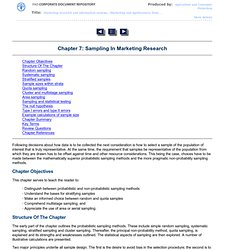

Tom Pisello: The ROI Guy: How many survey questions do you recommend for a typical Diagnostic Assessment Tool? Chapter 7: Sampling In Marketing Research. Chapter Objectives Structure Of The Chapter Random sampling Systematic sampling Stratified samples Sample sizes within strata Quota sampling Cluster and multistage sampling Area sampling Sampling and statistical testing The null hypothesis Type I errors and type II errors Example calculations of sample size Chapter Summary Key Terms Review Questions Chapter References Following decisions about how data is to be collected the next consideration is how to select a sample of the population of interest that is truly representative.

At the same time, the requirement that samples be representative of the population from which they are drawn has to be offset against time and other resource considerations. This being the case, choices have to be made between the mathematically superior probabilistic sampling methods and the more pragmatic non-probability sampling methods. Chapter Objectives. Questionnaire Design and Surveys Sampling. We must study the behavior of the mean of sample values from different specified populations.

Because a sample examines only part of a population, the sample mean will not exactly equal the corresponding mean of the population. Thus, an important consideration for those planning and interpreting sampling results, is the degree to which sample estimates, such as the sample mean, will agree with the corresponding population characteristic. In practice, only one sample is usually taken (in some cases such as "survey data analysis" a small "pilot sample" is used to test the data-gathering mechanisms and to get preliminary information for planning the main sampling scheme).
However, for purposes of understanding the degree to which sample means will agree with the corresponding population mean, it is useful to consider what would happen if 10, or 50, or 100 separate sampling studies, of the same type, were conducted. How consistent would the results be across these different studies? Is Var( Www.statpac.com/surveys/surveys.pdf. Www.zoomerang.com/resources/DS_SurveyDesign_Chklist.pdf. Survey Research. « PreviousHomeNext » Survey research is one of the most important areas of measurement in applied social research.

The broad area of survey research encompasses any measurement procedures that involve asking questions of respondents. A "survey" can be anything form a short paper-and-pencil feedback form to an intensive one-on-one in-depth interview. We'll begin by looking at the different types of surveys that are possible. These are roughly divided into two broad areas: Questionnaires and Interviews. Copyright �2006, William M.K. Www.mtsac.edu/administration/research/pdf/tips/SurveyDesignandProcess.pdf. Www.iiep.unesco.org/fileadmin/user_upload/Cap_Dev_Training/Training_Materials/Quality/Qu_Mod8.pdf. Designing a Survey. Please ensure you have JavaScript enabled in your browser.
If you leave JavaScript disabled, you will only access a portion of the content we are providing. <a href="/science-fair-projects/javascript_help.php">Here's how. </a> The key to obtaining good data through a survey is to develop a good survey questionnaire. Whether you are conducting interviews or mailing out surveys, you will need to know how to design a good survey questionnaire. What is a survey questionnaire? Survey questionnaires present a set of questions to a subject who with his/her responses will provide data to a researcher. Objectives The key to developing a good survey questionnaire is to keep it short while ensuring that you capture all of the information that you need.
Now that you know what you are looking for, you can begin to structure the questions that will help you capture the information. Types of Questions: There are two different types of questions that can be used to collect information. Credits. Www.socsci.uci.edu/ssarc/sshonors/webdocs/designtips.pdf. s3.amazonaws.com/SurveyMonkeyFiles/SmartSurvey.pdf. Survey Design Tips - Online Surveys - 400+ Free Survey Templates. Survey Design - How to Begin your Survey Design Project - Creative Research Systems. Knowing what the client wants is the key factor to success in any type of business.

News media, government agencies and political candidates need to know what the public thinks. Associations need to know what their members want. Large companies need to measure the attitudes of their employees. The best way to find this information is to conduct a survey. This chapter is intended primarily for those who are new to survey research. The Steps in a Survey Project This page covers the first five steps. Establishing Goals The first step in any survey is deciding what you want to learn. The potential market for a new product or service Ratings of current products or services Employee attitudes Customer/patient satisfaction levels Reader/viewer/listener opinions Association member opinions Opinions about political candidates or issues Corporate images These sample goals represent general areas.
Selecting Your Sample There are two main components in determining whom you will interview.